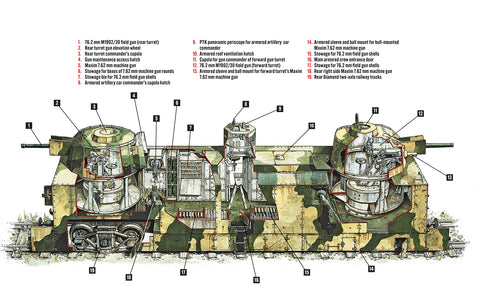
PL-37 Light Artillery Wagon: The Armored Russian Train That Fought in the Ukraine During WWII
PL-37 Light Artillery Wagon Specifications
- Manufacturer: Krasny Profintern Plant, Bryansk
- Length: 48 feet 2 inches
- Width: 9 feet 9 inches
- Height: 14 feet 5 inches
- Chassis: 55-ton wagon on Diamond two-axle trucks
- Main armament: Two 7.62 mm M1902/30 field guns
- Secondary armament: Six Maxim 7.62 mm water-cooled machine guns
- Ammunition: 560 76.2 mm shells and 30,000 7.62 mm rounds
- Armor: .78-inch sides, .59-inch roof
- Observation: Triplex glass visors; one PTK panoramic periscope for commander
- Crew: 30
As trains and the rail networks they plied improved and proliferated through the 19th century, their initial role as wartime transports led inevitably to their development as mobile weapons. The first armored trains were Austrian improvisations fielded during the Hungarian Revolution of 1848. The opposing sides in the American Civil War also used armored, cannon-armed trains. Such rolling batteries reached their peak use and development during World War I, especially on the Eastern Front, where Austro-Hungarian and Russian designs supported their respective armies. Following the 1918 armistice they saw further use by Red and White armies alike during the Russian Civil War, as well as by the forces of a resurrected Poland.
The Western and Eastern fronts of World War II witnessed the last widespread use of armored trains, with a renewed emphasis on anti-aircraft capability. The Soviet Union relied on its proven designs, while Germany, which during World War I had fielded largely improvised armored trains, introduced and made widespread use of its own original designs.
Standing out among the Soviet armored railcars was the PL-37 light artillery wagon, modified from earlier armored train designs that incorporated PL-35 tanks placed atop flatcars and flanked by armored walls. Large though the PL-37 appeared, its 30-man crew found the interior quite cramped due to its generously stocked ammunition supply. Produced between 1939 and ’41, some two dozen PL-37s saw use during World War II. The example above, No. 2 Za Rodinu (“For the Motherland”) was attached to the Twelfth Army, on the Southern Front, in October 1941. There it participated in the Russian offensive for control of Donbass in eastern Ukraine, site of more recent struggles in the headlines.
